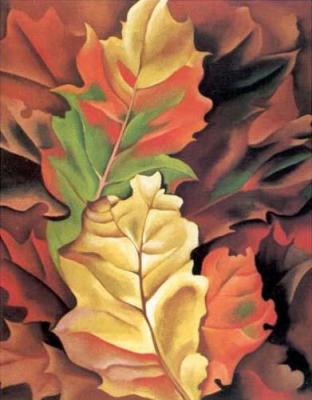 Autumn Leaves - October 28, 2009 Jeff Schalau, Associate Agent, Agriculture & Natural Resources University of Arizona Cooperative Extension, Yavapai County Chlorophyll, the green pigment in plant leaves, captures light energy then transfers and stores it as chemical energy in sugars and starches: this is the process of photosynthesis. Although chlorophyll is the best known of the plant pigments, other pigments are present in plants. Carotenoids are the yellow and orange pigments in carrots and other yellow/orange vegetables. Anthocyanin pigments are purple and red plant pigments and found in red cabbage, chard, and turnips. Carotenoid and anthocyanin pigments are present in most plant leaves throughout the growing season, but are masked by chlorophyll. As fall approaches, we may observe leaves changing color from green to yellow, orange, red, and even purples. Fall leaf colors are produced when weather interacts with physiological plant processes to cause color changes. Chlorophyll formation also slows down. A decrease in green pigment allows the yellow pigments to become more visible. Chlorophylls and carotenoids are held within membrane-bound structures within the leaves called plastids. Anthocyanins are produced by different processes and are found in the cell sap (cytoplasm). Fall weather conditions favoring formation of brilliant red autumn color are warm sunny days followed by cool, nights with temperatures below 45 degrees F. Much sugar is made in the leaves during the daytime, but cool nights prevent movement of, sugar from the leaves. When this occurs, sugar breakdown processes change leading to the production of anthocyanin resulting in red to purplish fall colors. Different plant species have varying ratios of chlorophyll to other pigments. They also have widely varied physiological processes and leaf chemistry. This is the reason for the wide variation in fall color between deciduous tree species and even individuals within the same species. Aspens have little or no anthocyanin while Rocky Mountain maples have enough to make them pink to red. Purple leaf plum trees have abundant anthocyanins throughout the growing season. Landscape trees that provide good fall color are: sweet gum (Liquidambar styraciflua) which has many named varieties that produce yellow, orange, red, and purple fall color and Chinese pistache (Pistacia chinensis) which produces rich red fall color. What happens to the deciduous leaves after the fall color show? Again, complex biochemistry is taking place within the plant. The technical term for leaf drop is abscission. In deciduous trees, the attachment of the leaf to the stem is designed to fail at the proper time. This abscission zone is characterized by two or more layers of cells: some with poorly developed cells walls to make it purposely weak and others that form a protective layer that can be “walled off” and sealed after the leaf drops. A leaf is an expensive investment for any plant. To simply allow it to drop would be a great waste. Consequently, many complex molecules are broken down into smaller units and transported from leaves into stems, down the trunk, and into the roots. This allows deciduous forest trees to survive in nutrient poor environments by salvaging nutrients before leaves are dropped. After the tree has recycled many of the materials, other processes take over. Auxin (growth hormone) levels decrease in the leaf, ethylene production increases, and enzymes are secreted that weaken the abscission zone to the point of separation. The leaf drops to the ground. Here, they lie until soil microbes, worms, and insects help decompose them to release nutrients for the tree or other plants to use again. The organic matter contained in the leaves is eventually broken down into humus which enriches the soil. On a another subject, I have received some calls regarding a decline of sugar bush (Rhus ovata) in the Coffee Pot Dr./Soldier Pass Rd neighborhood. I have visited the area and looked at several affected plants. Many plants have lost leaves and some remaining live leaves have some dead tissue on their margins. At this point, I believe this was caused by the relatively dry summer and the plants should recover. If your plants have these symptoms, you can apply deep irrigation with a soaker hose near the drip line once per week until we receive winter precipitation. The University of Arizona Cooperative Extension has publications and information on gardening and pest control. If you have other gardening questions, call the Master Gardener line in the Cottonwood office at 646-9113 ext. 14 or E-mail us at cottonwoodmg@yahoo.com and be sure to include your address and phone number. Find past Backyard Gardener columns or submit column ideas at the Backyard Gardener web site: http://cals.arizona.edu/yavapai/anr/hort/byg/. |